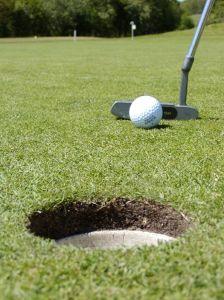Learn to Putt
Many golfers spend an extraordinary amount of time learning to make
an awesome drive. In truth, there’s nothing prettier than the golf ball
flying through the air and bouncing neatly onto the green – except the
ball dropping neatly into the cup. While working on those longer shots
is important, poor putting skill can literally lose the game.
Learning to put accurately every time can be a great expenditure of
your time. Consistently getting to the green isn’t going to do you a lot
of good unless you’re able to drop the ball once you’re there. Take a
few tips from the pros regarding the successful putt.
The “yips” are the bane of many golfers on the putt. This is simply a
hesitation – rather like a hiccup – that causes you to get a less-than-
smooth putt. A smooth stroke will always lend you better control over
the ball.
When you’re practicing your putt, pay attention to that accuracy. If
you’re having trouble controlling the line of travel, give yourself some
help until you get a better feel for the game. You might find it helpful
to make a mark on your club to clearly indicate the center of the
putter. Marking the ball may also help you make a very solid swing.

Chalk is a good way to make these
marks, because it will easily wipe off
after your practice session.
Try making yourself a mental picture of
the pathway the ball should travel. If that
mental picture doesn’t help, try laying a
piece of string along the ground between
your ball and the cup. It may seem like a
very simple thing, but watching the point
that your ball veers can help you figure
out what to do to correct the problem.
Too much spin on the putt can create some problems as well. Spin is
one of the most difficult things to control, and the short distance at the
putt is all about control.
If it’s a long putt, resist the urge to put too much muscle into the
swing. Avoid unnecessary loft. The higher your ball travels, the less
control you have over it.
You also have to resist the urge to overshoot your target.
Overshooting is a problem in many sports – not just golf. Imagine the
number of times you’ve seen someone take a shot at a pool table only
to have the ball ricochet off the back of the pocket and bounce back
out. The same sometimes happens with baseball, football and
basketball when the person throwing oversteps the amount of power
needed to make a successful play. It’s human nature to overthrow.
Guard against that at the putt. There’s little more frustrating than to
walk past the cup to the new putting position which is even farther
from the cup than the last – all because your swing was simply too
powerful and the ball passed over the top of the cup.
When you’re ready to putt, take a moment and take control before you
take the swing. Remember that the control is every bit as important as
your aim.




